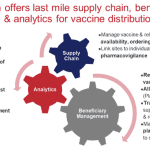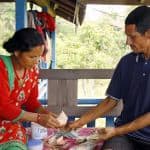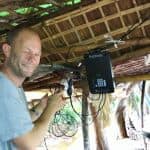Elbow to Elbow: Convening Donors and Practitioners to Optimize Blended Finance for African Agriculture
Editor’s note: This is the second article in a series from Aceli Africa, exploring challenges and solutions in agricultural investing in Africa. Part one of the series ended with two questions: 1.) How much subsidy is required to catalyze a functioning capital market where one barely exists today? 2.) How can that subsidy be targeted to align market growth with social and environmental impact? We’ll explore those questions in the article below. Part three shares perspectives from lenders in the region and unpacks Aceli’s data findings, particularly those that illustrate the under-recognized role of high transaction costs in limiting capital flows for African agricultural small and medium enterprises (SMEs).
Nairobi, Kenya. November 2019. Eight faces silently study the projector screen in the conference room. Donors have gathered to hear findings generated by Aceli and our data partner, Dalberg Advisors, on the (un)profitability of lending to agricultural small and medium enterprises (SMEs) in Africa, and to discuss Aceli’s proposed solutions. Someone crunches a cookie; another pours more pineapple juice. For a time, nobody speaks.
Finally, one donor says: “I understand why subsidies are needed to get the market moving, but the optics of paying banks to make loans are complicated.” Another adds: “How do we know the difference between systemic market dysfunction that we should be addressing and bad lending?”
Hours later, my Aceli colleague Etienne Ndatimana makes the same presentation, this time with the donors crowded elbow-to-elbow with representatives from commercial banks in Uganda and Kenya, state agricultural banks in Rwanda and Tanzania, specialist lenders focused on equipment leasing and factoring, and international social impact lenders. Their institutions had collectively shared data on over 9,000 loans totaling $3.7 billion, enabling the first-of-its-kind quantitative analysis on the economics of agri-SME lending that we were presenting.
A Ugandan banker speaks first: “The 50% loan guarantees we’ve been offered in the past aren’t high enough to cover the risks of lending in agri.” A Tanzanian lender follows: “The returns on smaller loans don’t cover the transaction costs when you have to drive seven hours just to meet the client.”
For the three years we were gathering data and designing Aceli, my colleagues and I ping-ponged between these perspectives. On the one hand, we encountered donors who wanted to get more capital flowing to African agricultural SMEs but who were hesitant to fund the kind of subsidies for agricultural and small business lending that are established policy in their own countries. And on the other hand, we heard from lenders who wanted to serve this market but knew from experience or intuition that the economics didn’t work.
The Limitations of Blended Finance
The challenges we faced in bridging the perspectives of donors and private capital providers are common across the development sector, and they extend beyond agriculture. In recent years, the development community has sized up the $2.5 trillion annual financing gap needed to achieve the SDGs by 2030 and concluded that the roughly $160 billion in official development assistance won’t get the job done.
Enter blended finance, which is premised on the belief (or perhaps the hope) that a bit of public or philanthropic funding plus a lot of commercial capital equals sustainable development. Convergence estimates that blended finance has mobilized $4 in commercial capital for every $1 of concessional capital, but qualifies that the majority of this “commercial” capital comes from public development finance institutions (DFIs) as opposed to private sector investment. These capital leverage ratios pale in comparison to the need, and blended finance vehicles still often fall short of achieving the type or depth of impact they’re targeting.
OECD, IFC, Convergence and others have produced a growing body of principles and reports on blended finance. Yet this relatively nascent practice tends to produce bespoke deals and funds as opposed to the sort of systemic solutions that could truly move the needle in sectors like agricultural finance. There are a few reasons for these limitations:
- Creative deal-making prevails: The actors financing a deal tend to secure as much concessional funding as they can — a reasonable approach in the absence of more objective standards defining appropriate levels of subsidy based on the sector, geography and impact they are targeting.
- Risk-return hurdles drive investment decisions: Though impact is emphasized in marketing these transactions, there is minimal accountability when it comes to capital additionality or impact in the actual design or implementation of most blended finance vehicles.
- Blending is done at the level of individual transactions or funds: That means that individual actors compete on an uneven playing field based on which are best at fundraising, as opposed to which can deliver impact most efficiently in a competitive marketplace.
Over the past decade, several high-profile funds have been established with generous tranches of catalytic capital, usually from DFIs, and a stated goal to serve the agricultural missing middle. However, once operational, these funds have gravitated to larger — albeit still risky — transactions of $2-5 million or more, in order to achieve the financial returns required by the investors that were catalyzed in the first place. That means SMEs requiring smaller ticket sizes (under $1 million) or deemed to be higher risk remain unserved. Thus, much of the limited catalytic capital available for the agricultural SME finance market has been tied up in vehicles that are minimally addressing the gap that is hardest to serve — but where the opportunity for inclusive economic development may be greatest.
Optimizing Blended Finance for Impact at Scale
So where does that leave us in considering how to leverage catalytic capital efficiently to benefit agricultural SMEs (or other sectors facing similar challenges)? Aceli Africa bridges the finance gap to unlock the growth and impact potential of agricultural SMEs in Africa, by providing financial incentives to increase lender appetite to serve these businesses, and technical assistance so more businesses are prepared to access and manage financing. In responding to the opening questions in this article (“How much subsidy is required to catalyze a functioning capital market where one barely exists today?” and “How can that subsidy be targeted to align market growth with social and environmental impact?”), our approach is defined by the following characteristics:
Data driven: Aceli’s financial incentives for participating lenders are calibrated to the data we gathered on the economics of agri-SME lending. These incentives include: 1.) portfolio first-loss coverage to increase lender risk appetite beyond traditional loan guarantees; and 2.) origination incentives to compensate lenders for the transaction costs on smaller ticket sizes and those seven-hour drives to visit agri-SMEs (see here for more details on the incentives). Our initial pool of data grows continuously as more lenders sign up. This approach allows us to adjust incentives as market conditions evolve, dialing them down where less support is needed and dialing them up where the gaps and opportunity for impact are greatest.
Impact linked: Aceli’s incentives are tiered, based on the additionality and impact this capital can have. Impact bonuses are assigned for loans to first-time borrowers and enterprises that create economic opportunities for smallholder farmers and low-wage workers, promote gender inclusion, contribute to food security and nutrition in Africa, and practice climate-smart and resilient agriculture. By paying for demonstrable impact along the way — as opposed to pre-committing concessionary funding, as is common practice in blended finance facilities — Aceli embeds an accountability mechanism into how capital is channeled for impact.
Marketplace level: The lending data we gathered revealed that no single financial institution or fund serves the wide variety of financing needs among SMEs in the $25,000 to $1.5 million ticket-size range, yet many providers of catalytic capital continue to put all their eggs in one basket by funding a single blended finance vehicle. In contrast, Aceli works with a mix of lenders offering distinct financial products across this ticket-size range. This approach promotes a level playing field and incentivizes market actors to compete to deliver capital additionality and impact most efficiently.
Going to Market
When the donors who’d expressed skepticism about market-building subsidies during our presentation reconvened for dinner after hearing the lenders’ perspective in Nairobi, the mood had changed. Over the din of the football match on TV, the group leaned in to listen to a sector veteran: “We’ve tried so many things over the years, but we’ve been flying blind without any of this data and always pushing to get banks to do things that they didn’t really want to do. This feels different — Aceli is creating a market pull that just might work.”
Within months, USAID, the IKEA Foundation and the Swiss Agency for Cooperation and Development each committed $10 million to a pool of financial incentives Aceli had created, with the aim of mobilizing $700 million in lending to high-impact agri-SMEs by 2025. Twenty-five lenders, two-thirds domiciled in East Africa, signed up to participate in Aceli’s model. Enabled by this funding, in September 2020 — as COVID-19 disrupted agricultural value chains and lenders retreated in the face of uncertainty — Aceli Africa officially launched in Kenya, Rwanda, Tanzania and Uganda.
Over the past eight months, Aceli has supported $8.4 million in lending to 60 SMEs, with more than half of them accessing financing for the first time. Amidst the added challenges of the pandemic, Aceli’s incentives will support lenders in responding to rising demand for financing from agri-SMEs so they, in turn, can purchase more from smallholder farmers, employ more workers, and supply more food for Africa’s growing population.
Part three of this series will tackle the often-overlooked barrier of transactions costs, alongside risk, in limiting capital flows in frontier markets.
Brian Milder is the Founder and CEO of Aceli Africa.
Photo by Jennifer Huxta / Mastercard Foundation.
- Categories
- Agriculture, Investing



